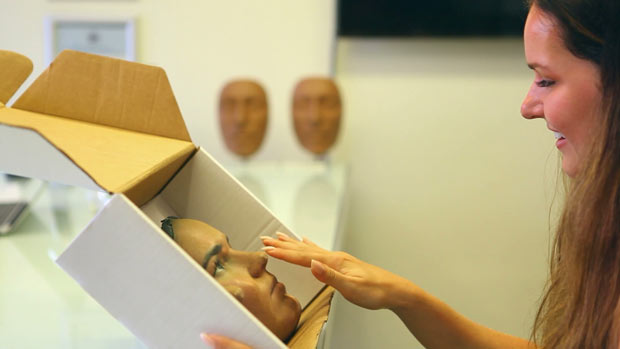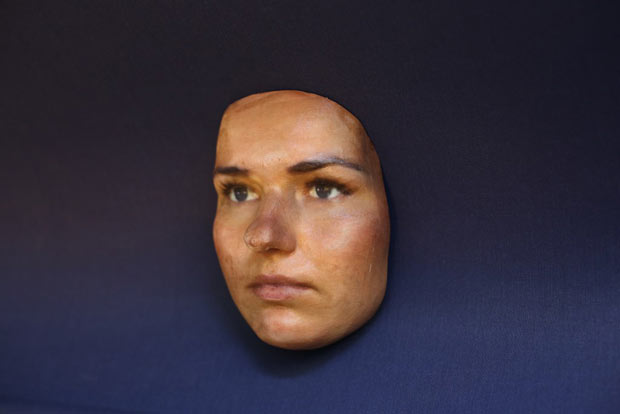
For his patients, Dr. Avsar uses 3D printing to help them visualize any facial changes during surgery. Image courtesy of Mcor Technologies.
Latest News
May 1, 2016
Clear communication and understanding between a surgeon and his or her patient is vital before emotion-filled plastic or reconstructive surgery. That’s why Dr. Yakup Avşar, founder of AVSAR Aesthetic Surgery Clinic in Istanbul, Turkey, combines his knowledge and expertise as an aesthetic, plastic and reconstructive surgeon with his talent as a sculptor to create physical three-dimensional “before” and “after: images of his patients’ faces. Showing his patient a physical comparison between what their face looks like now versus what it will look like after surgery enables Dr. Avşar to set their expectations and come to an agreement with them about the changes that will take place.
 One of Dr. Avsar’s masks, created with 3D scanning and one of Mcor’s systems. Image courtesy of Mcor Technologies.
One of Dr. Avsar’s masks, created with 3D scanning and one of Mcor’s systems. Image courtesy of Mcor Technologies.Originally, Dr. Avşar hand-sculpted the masks of his patients’ faces. But the monochromatic sculptures were time-consuming to create and modify and not as realistic as he needed to accurately convey to his patients the changes that would occur in surgery.
Better Color at Lower Costs
After seeing a demo of 3D scanning and 3D printing, Dr. Avşar recognized the benefits of these two complementary technologies in producing more realistic physical 3D models of his patients’ faces faster than the handcrafting technique.
Dr. Avşar initially used a powder-based 3D printer for this application, but switched to an Mcor full-color 3D printer because of Mcor’s superior color capability, lowest operating costs and environmentally-friendly process.
“We always prefer to use eco-friendly, stable and economic 3D printers,” said Dr. Avşar. “Also, the colors produced on the Mcor 3D printer are far better then those produced on other 3D printers.”
On-Demand 3D Printing
During a patient’s initial office visit, Dr. Avşar creates a 3D scan of their face with an Artec handheld 3D scanner. Next, he uses Autodesk’s 3ds Max 3D modeling software to prepare the digital 3D model generated by the scan for 3D printing. He also modifies the scan data to create the post-surgery image of the patient’s face.
Both digital 3D images are then sent to the Mcor 3D printer to produce the life-size photorealistic-color masks of the patient’s face, right in Dr. Avşar’s office. Dr. Avşar and his patient review and discuss the 3D printed masks and make modifications, as needed, to the post-surgery mask for further review. Once Dr. Avşar and his patient agree on the scope of the surgical modifications, they proceed with the surgery.
Satisfied Patients and Growing Practice
Dr. Avşar says: “It is what the patients want. Before this, it wasn’t possible for us to show patients exactly what their face would look like following surgery. Enabling them to see and feel the realistic three-dimensional mask of their face gives patients a far greater understanding of the surgical results they can expect. This technology is powerful for patients in everyday practice.”
 For his patients, Dr. Avsar uses 3D printing to help them visualize any facial changes during surgery. Image courtesy of Mcor Technologies.
For his patients, Dr. Avsar uses 3D printing to help them visualize any facial changes during surgery. Image courtesy of Mcor Technologies.Dr. Avşar produces approximately 20 full-color 3D printed models per month. He believes he is the only aesthetic plastic surgeon in the world currently utilizing the 3D scan-to-3D print process in this way and it is quickly beginning to pay off.
He believes that this process is applicable to patients requiring any type of surgical body modification and that it will only continue to expand as more surgeons integrate full-color 3D printing into their own practices.
More Info
Subscribe to our FREE magazine, FREE email newsletters or both!
Latest News






